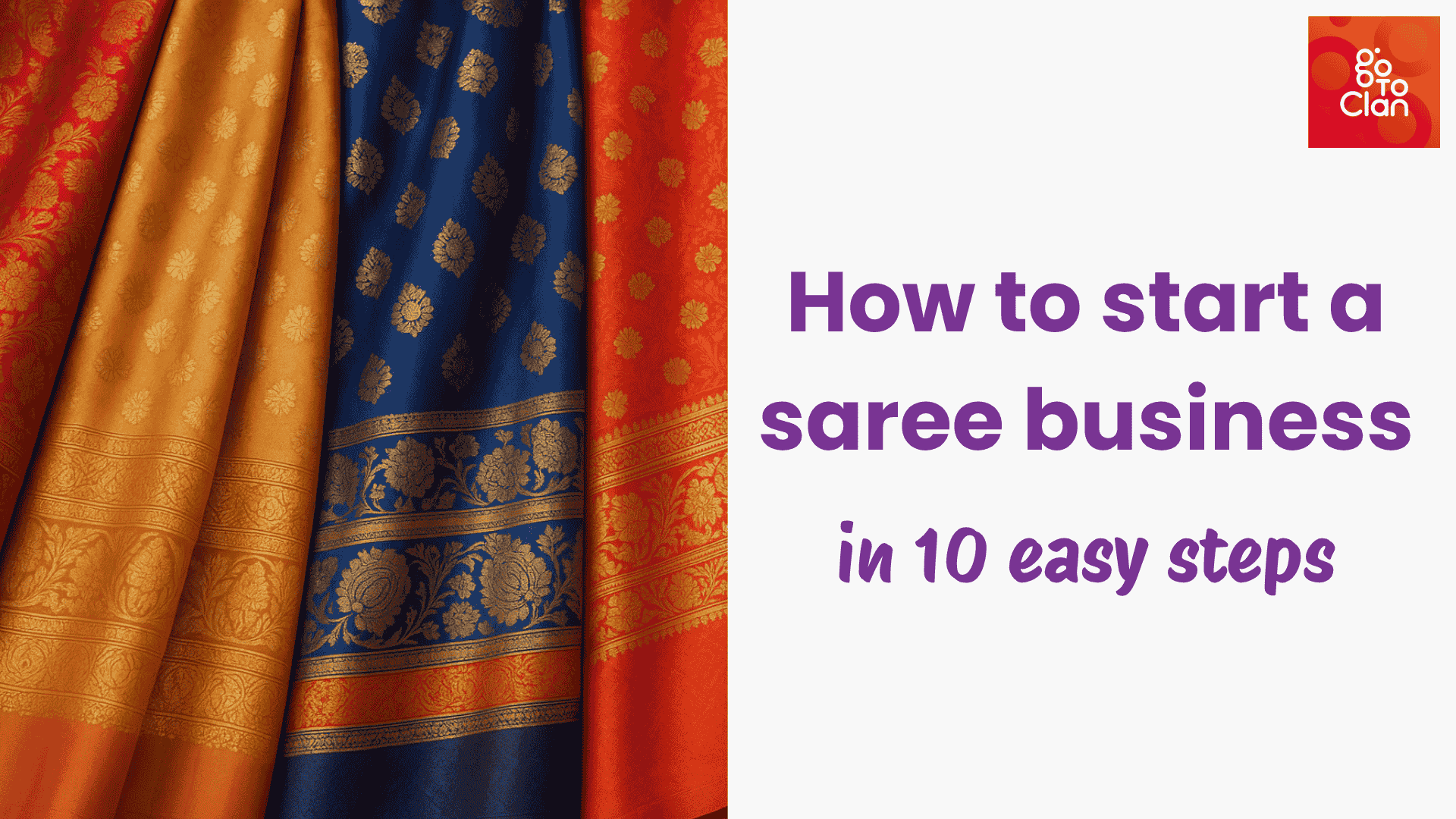
Are you looking for a profitable side hustle in India? A saree business is one of the ventures that offers high profit margins and long-term sustainability. It not only boosts profits with low investment but also performs well despite high competition.
You might be wondering how to start saree business from home when there’s a saree shop on every corner. But here’s the thing, women don’t shop only when they need something; they shop when they like something. Hahaha… well, that’s my theory. But I’m sure you agree!
So, if you want to know how to start online saree business from home, I’ve got the answer.
10 steps of how to start saree business from home
Step 1: Select the type of saree you want to sell
Decide what type of saree you want to sell in your online shop. It’s very important to finalize this, as the next crucial steps are all connected to your choice.
There are plenty of saree types, such as:
- Banarasi – Rich silk sarees from Varanasi with gold/silver zari work.
- Kanjivaram – South Indian silk sarees with temple borders and vibrant colors.
- Chanderi – Lightweight, sheer sarees with soft silk and cotton blend.
- Bandhani – Tie-dye style sarees from Gujarat and Rajasthan.
- Patola – Double ikat woven sarees from Gujarat; very intricate.
- Tant – Crisp cotton sarees from Bengal, great for daily wear.
- Kota Doria – Lightweight sarees from Rajasthan with square checks.
- Maheshwari – Elegant cotton-silk sarees with zari borders.
- Paithani – Maharashtrian silk sarees with peacock and floral motifs.
- Organza – Transparent, classy sarees with embroidery or print.
- Linen – Breathable, modern look, perfect for summer.
- Georgette/Chiffon – Flowing and trendy, often used in partywear.
- Tussar Silk – Raw silk with a rich texture, mostly in earthy tones.
- Bhagalpuri – Wild silk sarees from Bihar; eco-friendly and unique.
- Narayanpet – Border-focused sarees from Telangana, usually checked.
Once you select a few saree types from this list, you will get a clear idea of your customers. How? Let’s understand the next step.
Step 2: Understand your target audience
Banarasi and Kanjivaram sarees are quite expensive, and therefore, the target audience belongs to the higher income class. This is a small customer segment. Such a niche group of women prefers purchasing authentic sarees from traditional shops and wholesalers.
If you decide to go with partywear sarees at mid-range prices, it’s a great choice for beginners. These sarees offer higher profit margins and are loved by most women. Ladies often prefer sarees like Tussar Silk, Narayanpet, Paithani, Georgette, and Chiffon for parties and events.
You can also choose to sell regular-wear sarees such as cotton, linen, and synthetic ones. Working women prefer these sarees to enhance their personalities at the workplace. They are super comfortable and reasonably priced.
Step 3: Branding in the initial phase is important
Wondering why I mentioned branding in the first 3 steps? Because it is the face of your business. Many women make the big mistake of not converting their small household business into a brand. Who said branding is only for big companies? Branding activities give your business an identity.
This is a fun step, as you get to decide the name of your business. You can hire a branding agency like Go To Clan to design a logo. You can also think of a cool tagline. If there’s a story behind starting your business, that’s a bonus! Let people know you for your effort and journey, not just your sarees.

Branding is not limited to logos and brand names, it’s much more than that. From custom packaging to brand voice, you can transform your side hustle into a full-fledged business. If you’re going to sell Banarasi and Paithani sarees, you must present yourself as a premium brand to win the trust of your customers. Would you pay ₹20,000 for a Banarasi saree to someone who doesn’t even have a proper brand logo? No, right?
Step 4: Register your business
1. Register Your Business Name
Choose a unique and relevant name for your business and register it with the Ministry of Corporate Affairs (MCA) or your state authority to ensure legal recognition and brand protection.
2. Choose a Legal Business Structure
Decide the type of business entity that suits your goals, Sole Proprietorship (single owner), Partnership Firm (shared responsibilities), or Private Limited Company (limited liability and easier funding access). Each has its pros and legal implications.
3. Apply for Licenses and Permits
Based on your industry, location, and business model, obtain mandatory licenses such as a Shop Act license, or Import Export Code (for international trade). Ensure full regulatory compliance.
4. Complete Tax Registrations
Register for Goods and Services Tax (GST) if your turnover exceeds the prescribed limit or you deal in inter-state trade. Also, apply for PAN, TAN, and other tax-related requirements as needed.
Step 5: Where are you planning to get your sarees from?
This is the step where a lot of effort is required. You will need to do your homework based on the type of saree you finalize. There are different wholesalers in the market who deal in various types of sarees.
Wholesale Hubs by Region:
1. Surat, Gujarat – Georgette, Chiffon, Synthetic, Printed
2. Varanasi, UP – Banarasi Silk
3. Kanchipuram, TN – Kanjivaram
4. Coimbatore, TN – Cotton sarees (budget-friendly)
5. Pune, Maharashtra – Paithani
6. Hyderabad, Telangana – Pochampally, Narayanpet
7. Mumbai, Maharashtra – Readymade/partywear sarees
Platforms to Connect With Wholesalers:
- IndiaMART – Direct suppliers for all saree types
- TradeIndia – Bulk ethnic wear deals
- B2B platforms like Udaan or Shop101 – Good for starting an online resale
- WhatsApp Groups/Telegram – Many wholesalers run daily update groups
- Local exhibitions / Craft fairs (Dastkar, Dilli Haat) – Connect with weavers
Step 6: What quantity to buy?
There are two ways: take orders first and then order the lot of sarees, or order the lot first and then take orders.
Most vendors have an online presence. Check the Instagram pages and websites of the wholesalers you plan to buy from. Download the images, price details, and other information like material, washing instructions, etc. Shortlist a few sarees to order. Usually, such wholesalers do not accept low-quantity orders like 4–5 sarees. Even if they do, they charge more. That’s why you can shortlist sarees, circulate those images within your circle, take orders, and then place the final order.
If you decide to go ahead with the second option, I suggest buying 10–15 sarees to start with. Always play it safe.
Make sure you ask these questions to your vendors:
- Do you have a credit system?
- If I am not able to sell the sarees, can I return the unsold sarees?
- Can I order at a discounted price for the initial months?
These questions are important as you can calculate the investment based on the answers.
Step 7: Start an online store
Here is the answer to your question- how to start online saree business from home. No, it’s not rocket science. I know it sounds too technical, but it’s not. Go To Clan can help. We are experts in designing and developing simple e-commerce sites for small businesses.
While building your online presence, keep in mind that customers should be able to find you easily. They should be able to explore different types of sarees in just a few clicks.
At the same time, the website should load quickly. This not only helps with online marketing but also keeps every user engaged when they visit your website.

Step 8: A professional photoshoot is a must
By a professional photoshoot, I am not recommending hiring a premium photographer. You can do the photoshoot at home as well. Use a phone with good camera quality, arrange proper lighting, and click photos.
You can use these photos for the website, WhatsApp catalog, Instagram posts, and other marketing campaigns.
Step 9: Online marketing can do miracles
Networking and spreading the word about your business is a traditional marketing strategy. However, online marketing can help you reach an audience that you cannot reach through traditional methods.
There are multiple ways to use online marketing. First of all, create a dedicated page on Instagram and Facebook. Optimize the pages with an apt bio, HD images, quirky captions, etc.
In this world of reels, you can wear sarees and film a short reel showcasing the details of your saree. Such reels perform well.
You can also consider running Meta ads online. Hire a professional agency that understands Meta ads and build a strategy with their help. I advise you not to run ad campaigns in-house, as the technicalities can be a bit difficult to understand.
Step 10: Everyone loves offers
How to start saree business on a limited budget? If this is your first concern, don’t worry. Offers can help you. Yes, you read that right. People love offers and discounts. I’m saying this openly – raise the original prices and call it a discount.
For example, if your Paithani price is ₹4000, you can raise it to ₹8000 and declare that you’re offering a whopping discount of 50%. I know it’s an old trick, but it works! Let’s do what works.
You can also announce fun offers for every Instagram follow, post reshare, user-generated post, review, etc. For instance, give 5% off on the next purchase to every customer who posts a photo wearing your saree and tags your business page.
Final Words
If your main concern is: How to start saree business from home all by yourself? We can help you. From go-to-market strategy to Instagram reels, we can be your go-to partner.
Go To Clan understands that every small business needs a partner that treats the business like its own. We love uplifting small businesses and watching them grow.
GET IN TOUCH